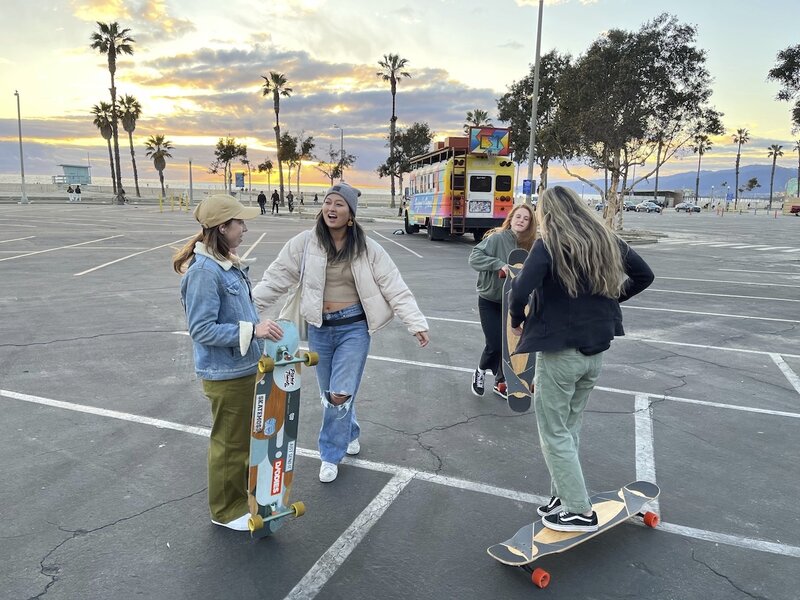It's tricky, exciting, and it's a new trend: Longboard dancing
Loading...
| Santa Monica, Calif.
This winter’s been a hard one in Southern California. Highways flood and the rain keeps coming. Pedestrians pick their way across fallen cypress trees and around puddles on sidewalks roped off with caution tape. Between fire, flood, and drought, sometimes it feels like the end of the world.
But tonight, there’s a break. Just east of the Santa Monica boardwalk, a dozen or so longboarders cruise in loping patterns along the empty stretch of South Lot 4, a mostly empty parking area.
Hannah Dooling glides down the pavement, earbuds hidden by long brown hair tucked beneath a baseball cap. She steps off her longboard, flips it in a semicircle in the air while taking a few running steps, and hops back on the board, landing with a resounding thud.
“That’s cool, right?” another woman asks.
It is, in fact, really cool. The trick is the half moon, named for the arc the board makes in the sky, and it’s one that Ms. Dooling has shown other women how to master. They include Yun Huang, a tech worker; and Jane Kang and Christie Goodman, who works as a nanny and real estate agent, respectively.
They’re all here in wide-leg pants and zero-drop sneakers for the longboard session, bundled against the wind in hoodies, puffer coats, or trucker jackets.
They get together most Saturday and Sunday afternoons if the weather’s good, at meetups supported by Dancing Foundation, a non-profit started with a matching grant from Google by Achille Brighton, a software engineer.
Longboard dance is still in its infancy, but Mr. Brighton says it has already spread – here, in Paris, in Seoul – anywhere with public squares or wide, open sidewalks where people can watch.
“You don’t need skate parks. You just need roads,” he says. “And because you do it in public, you’re out there, people see it. And they’re like, ‘Oh, that’s kind of cool.’”
Originally designed for surfers entertaining themselves between sets, most longboards range from 3 to 4 feet in length, about a foot longer than traditional skateboards. The longer decks can be cumbersome, but also graceful. They’re used for carving sidewalk turns and bombing hills, as well as longboard dancing, a skate/dance hybrid that fuses movement, music, and danger.
“When you’re doing longboard dancing, you’re listening to music, typically, and you’re moving your body to the beat,” Mr. Brighton says. “There’s this effect where the rest of the world melts away.”
Ms. Dooling was an early adopter, learning how to skate in Seattle. If anyone wants to learn a trick, she can probably show them how. She works remotely for Amazon and moved to Los Angeles with her partner in 2021 during “peak COVID,” not knowing anyone. Skating was a way to find community.
Ms. Huang, a native of Melbourne, Australia, started skating during the pandemic. Some days, her board and her dog were the only things that would get her outdoors and moving.
“We were all kind of depressed from COVID,” she says. “I tried meditation before. That didn’t work for me, but I felt like I could really be in the zone with this.”
At first, Ms. Huang just wanted to learn how to skate. Then she got sucked into “the longboard dancing hole of Instagram,” where a 30-second clip can be posted with music. That’s how Ms. Huang learned about Mr. Brighton and Longboard Dancing Los Angeles.
Says Ms. Dooling: “As a woman, skating can feel intimidating and not welcoming.” But during the pandemic, people were connecting through social media, finding their niche.
Longboard dance was featured in a commercial for Facebook Groups during the 2021 Tokyo Summer Olympics, showing skaters of different genders, races, and nationalities finding each other online. You could watch reels and think, “I identify, or I see myself, or connect with the people that I’m seeing doing this,” Ms. Dooling says.
Ms. Goodman, flashing a “rock on” sign with her index and pinky finger, says, “I was like, Tony Hawk!” The women laugh, but Ms. Goodman is semiserious. “Yeah! I was obsessed with him! And now I’m like, I can do some of those tricks!”
The four women jump in and out of the conversation, their speech overlapping. Ms. Kang is the most reticent, a former dancer attracted to the sport’s grace. Ms. Dooling is unassuming yet self-assured, a quietly rebellious “solo sporter” who grew up snowboarding and practicing Tae Kwan Do. Ms. Huang, also a snowboarder, sports a sea-green manicure and dark hair balayaged into blonde.
Ms. Goodman is animated, her long red hair moving with her as she gesticulates.
“Don’t laugh at me, I’m fulfilling my 12-year-old dreams, OK?” she says.
Ms. Goodman first stepped on a skateboard in 2021. Now she’s sponsored, as is Ms. Huang.
Ms. Goodman does downhill, descending inclines at rapid speed. It’s dangerous; it’s exciting; “it brings up all the emotions,” she says.
When one of the women lands a new trick, “we fully celebrate,” Ms. Goodman says.
The sun is lowering on the horizon, which is thick with clouds. The sand has turned gray and damp. Waves and wind have pushed sand onto the boardwalk, where it swirls and drifts in marbled patterns punctuated by footsteps, stroller wheels, and the tire patterns of a bike caravan glowing with LED lights, revolutions of pink and green slowly cycling towards the Ferris wheel.
The women, shivering in ripped jeans, want to make the most of the light that’s left. “We need to move,” Ms. Huang says, and, laughing, they glide off into the sunset.
This story was reported by The Associated Press.







